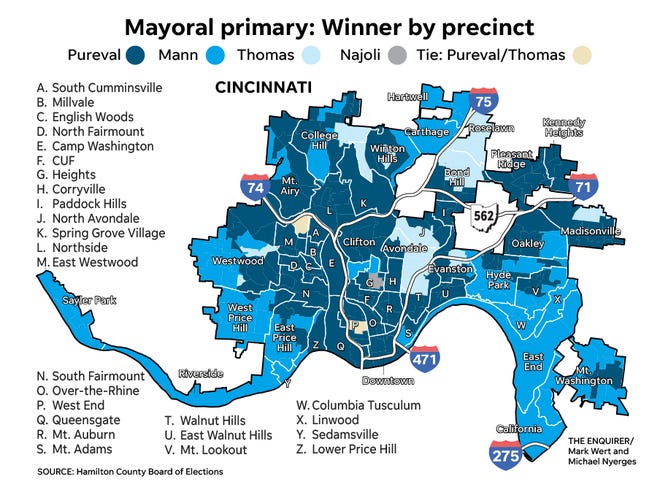

The top two vote-getters in Tuesday's mayoral primary took roughly 2 of every 3 votes cast by Cincinnati voters.
Our map shows the winner, Hamilton County Clerk of Courts Aftab Pureval, the best in central and northern neighborhoods. But it doesn't show that Pureval took first or second place (either alone or in a tie) in 187 of 190 city precincts.
PX column: Will Cincinnati's mayoral election even be competitive?
He did well in precincts with poor and strong voter turnout, precincts with high numbers of poor voters and high numbers of more well-to-do voters, an Enquirer analysis of the results shows. Pureval ran well in predominantly Black neighborhoods against Ohio state Sen. Cecil Thomas, a former city councilman, by placing a strong second in some and winning in others.
Mann was strongest in neighborhoods on the eastern and western edges of the city that also were the most strongly opposed to Issue 3.

Which Cincinnati precincts did Issue 3 struggle in?
If Pureval demonstrated strength citywide, Issue 3's results were the opposite. It had the worst of all possible worlds when it garnered only 27% of the vote.
The proposal won in only 15 of the city's precincts or 1 in 12. The pro-Issue 3 precincts were scattered across the center of the city, in Avondale, Evanston, Northside and Over-the-Rhine; all but one was west of Interstate 71. Even then, Issue 3 didn't pile up many votes, because 13 of the 15 precincts where it won had low voter turnout, the Enquirer analysis showed.
PX column: Surprise! Elections aren't won on Twitter
Meanwhile, in 48 precincts, the proposal faced a tidal wave of no votes of 80% or more. That means Issue 3 lost by 60 points or more in 1 of 4 precincts citywide.
The most strenuously anti-Issue 3 locations were on the eastern and western edges of the city. When a proposition or candidate gets shellacked this way in a significant portion of the city, victory is close to impossible.
Source link









